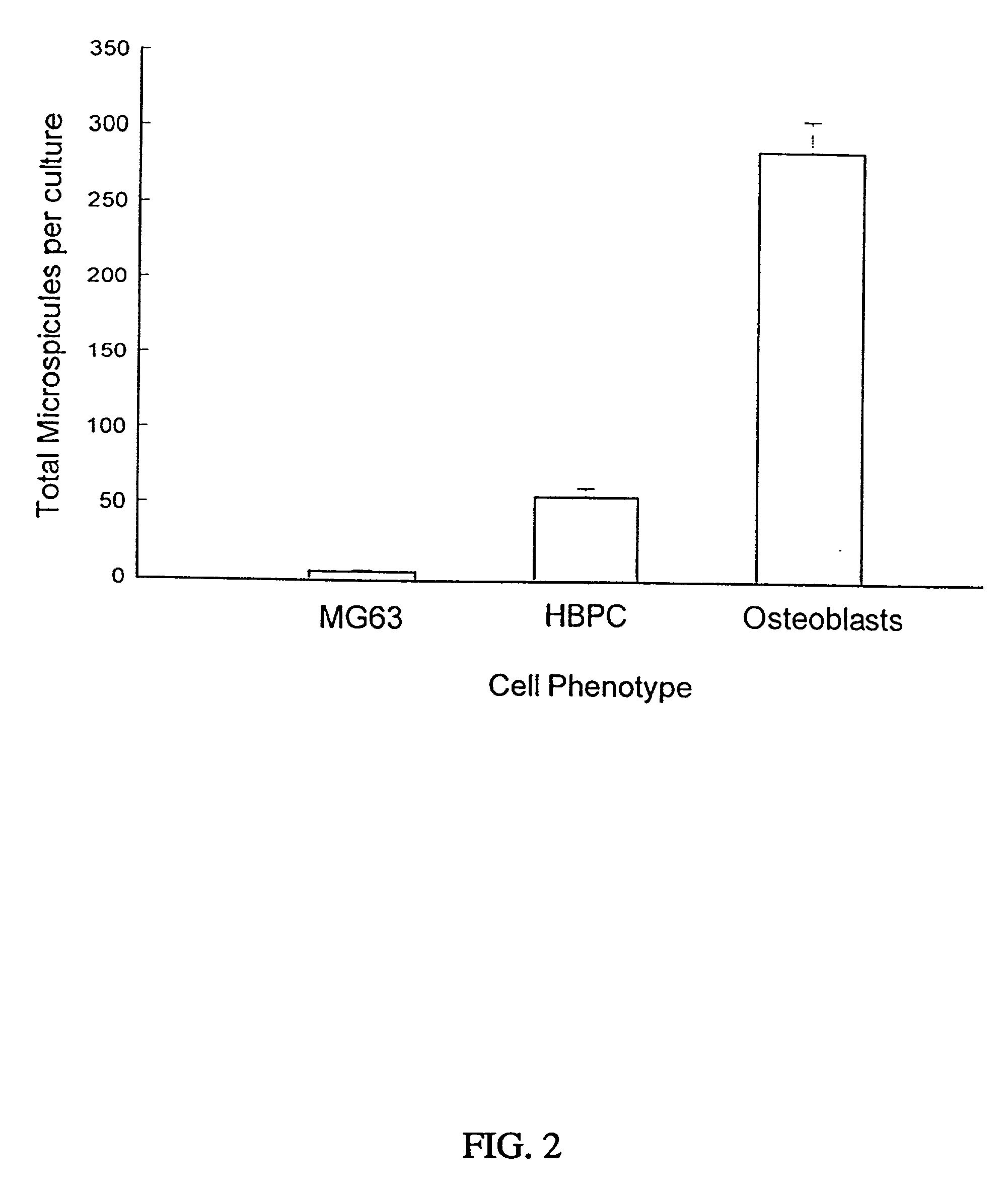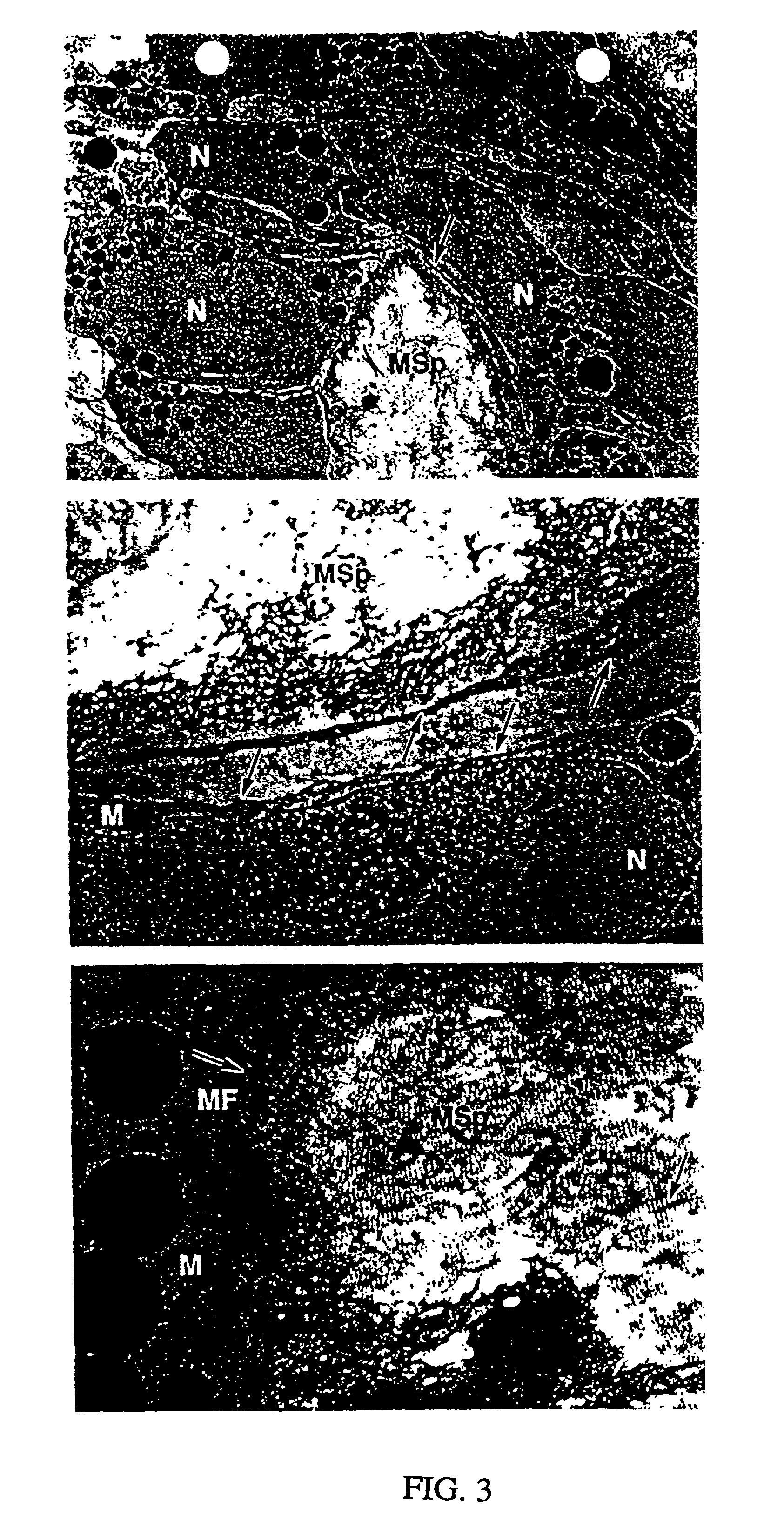Process for ex vivo formation of mammalian bone and uses thereof
a bone and mammalian technology, applied in the field of biological and medical science, can solve the problems of inability to directly demonstrate inability to extend in vivo spatial requirements to in vitro systems, and inability to conduct direct studies demonstrating the relationship between cell density and bone formation, etc., to achieve the effect of increasing the size of the resulting microspicule, inhibiting or acting synergistically
- Summary
- Abstract
- Description
- Claims
- Application Information
AI Technical Summary
Benefits of technology
Problems solved by technology
Method used
Image
Examples
second embodiment
[0046] Bone precursor cells can be further enriched by equilibrium-density centrifugation of bone marrow cells. Equilibrium-density centrifugation of bone marrow cells provides low density bone marrow cells enriched in bone precursor cells. In one embodiment, equilibrium-density centrifugation can be performed before the antibody purification. In a second embodiment, equilibrium-density centrifugation can be performed after the antibody purification. Alternatively, the equilibrium-density centrifugation purification step can be performed twice--before and after the antibody purification step.
[0047] In another aspect, the population of bone precursor cells can be enriched by removing stromal cells present in bone marrow cells. Removal of stromal cells can be accomplished by exposing bone marrow cells to an adherent surface, typically tissue culture plastic or glass. Stromal cells adhere to tissue culture plastic or glass while bone precursor cells do not. Stromal cells can be removed...
example 1
[0196] Materials and Methods
[0197] Culture of Osteogenic Cells and Cell Lines. Osteogenic cell lines such as human osteosarcoma cells (MG63) were cultured in RPMI 1640 (Gibco, Grand Island, N.Y.) containing 2 mM L-Glutamine, sodium pyruvate and 10% Fetal Calf Serum (FCS) (Hyclone Labs Inc., Logan, Utah). For bone cell spheroid formation, cells were grown to confluency, trypsinized, washed two times in RPMI, and immediately cultured in serum-free media containing 1% ITS+ (Collaborative Research Inc.) and 200pM TGF-.beta.1 (Collaborative). Unless otherwise noted, cells are plated at a density of about 10.sup.3 to 10.sup.6 cells / cm.sup.2 in tissue culture dishes. Control cells were allowed to adhere to plastic for 3-4 hours in serum containing medium following trypsinization. This adherent cell layer was then washed twice with serum-free medium and cultured as above with or without TGF-.beta.1.
[0198] Human Bone Precursor Cells (HBPC). Purified populations of HBPC were isolated from hum...
example 2
[0210] Formation of Bone Cell Spheroids and Microspicules
[0211] Given the role of cellular condensation in chondro / osteogenesis both in vivo (Hall and Miyake, 1995; Dunlop and Hall, 1995) and in vitro (Denker, 1995), the inventors reasoned that similar processes are involved in the ex vivo formation of human bone. To examine this hypothesis, the inventors utilized three populations of human osteogenic cells: the MG63, preosteoblastic osteosarcoma cell line (Franceschi, 1985) and other cell lines such as 3T3, SAOS2, and C310T1 / 2, immunologically purified human bone precursor cells (HBPC; a population of preosteoblast-like cells) (Long, 1995) and osteoblasts derived from collagenase-treatment of bone fragments (Robey and Termine, 1985 and Table 1). The inventors observed that serum-free treatment of these cell types with TGF-.beta.1 immediately following trypsinization and subsequent serum-free culture results in the formation of three-dimensional, spherical cellular condensates (cell...
PUM
 Login to View More
Login to View More Abstract
Description
Claims
Application Information
 Login to View More
Login to View More - R&D
- Intellectual Property
- Life Sciences
- Materials
- Tech Scout
- Unparalleled Data Quality
- Higher Quality Content
- 60% Fewer Hallucinations
Browse by: Latest US Patents, China's latest patents, Technical Efficacy Thesaurus, Application Domain, Technology Topic, Popular Technical Reports.
© 2025 PatSnap. All rights reserved.Legal|Privacy policy|Modern Slavery Act Transparency Statement|Sitemap|About US| Contact US: help@patsnap.com



